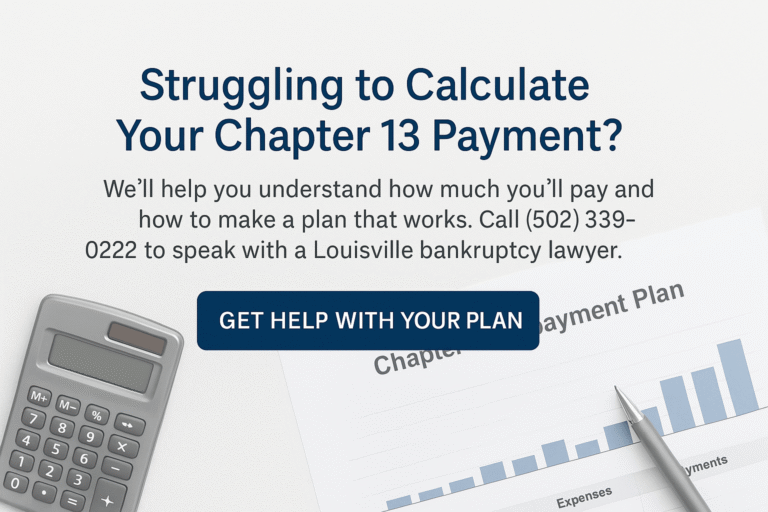Filing for Chapter 13 bankruptcy can provide individuals and families in Louisville and throughout Kentucky with a structured path to repay their debts while protecting important assets such as a home or vehicle. This tool is designed to give you a clear estimate of your potential monthly repayment amount based on your income, expenses, and debt. Working with an experienced bankruptcy lawyer in Louisville can help ensure the plan is accurate, realistic, and more likely to be approved by the court.
For guidance tailored to your financial situation, call (502) 339-0222 to speak with a trusted Louisville bankruptcy attorney. Our legal team can review your options, explain the Chapter 13 process, and help you move toward a more stable financial future.
Calculate Chapter 13 Payment
Use the calculator below to estimate your potential Chapter 13 monthly repayment amount. It considers key factors such as your income, household expenses, priority and secured debts, and any non-exempt assets. This gives you a practical starting point before creating a formal repayment plan.
Please note this estimate is for general informational purposes only and does not replace legal advice. Your actual plan amount will depend on trustee guidelines, court approval, and your specific financial situation. For a personalized analysis, call (502) 339-0222 to speak with an experienced Louisville bankruptcy attorney.
Kentucky Chapter 13 Payment Calculator (Simple)
Enter your information below to estimate your monthly Chapter 13 payment. This is only a general example and not legal advice.
How Chapter 13 Payments Are Calculated in Kentucky
Chapter 13 repayment plans are based on clear legal guidelines and your actual financial situation. Understanding how the amount is determined can help you plan ahead and make informed decisions before filing. This type of payment plan is designed to give individuals and families in Kentucky a structured path toward debt relief, while allowing them to keep essential assets like their home and vehicle.
The calculation typically considers several key factors, including:
- Monthly income (wages, spouse income, or other income sources)
- Household expenses such as housing, transportation, insurance, and food
- Secured debt arrears, including past-due mortgage payments or car loans
- Priority debts, including certain taxes or support obligations
- Non-exempt assets that must be factored into the best-interest test
- Trustee fees and filing costs required under Chapter 13
Your payment amount must meet specific legal standards. It should cover priority debts in full, apply disposable income toward repayment, and ensure unsecured creditors receive at least as much as they would in a Chapter 7 case. With the help of a knowledgeable bankruptcy lawyer Louisville, your payment plan can be structured to meet these requirements and improve your chances of court approval.
Chapter 13 Payment Example (Kentucky Family Scenario)
To give you a better idea of how a Chapter 13 repayment plan works, here’s a simple example based on a common financial situation in Kentucky. This example is for illustration purposes only — your actual payment will depend on your unique financial circumstances, trustee guidelines, and court approval.
Example:
- Household: Family of 4 in Louisville
- Gross Monthly Income: $7,800 (above median)
- Monthly Living Expenses: $5,500
- Priority Debts (taxes): $5,000 total
- Secured Arrears (mortgage): $10,000 total
- Unsecured Debt: $40,000
- Plan Length: 60 months
Estimated Payment Calculation:
- Disposable Income: $2,300 per month
- Base Plan Payment: $2,300 × 60 months = $138,000
- Priority and Secured Debts Paid in Full
- Estimated Unsecured Recovery: Approximately 80–85%
This example shows how monthly income, household expenses, and different types of debt work together to determine a Chapter 13 plan payment. An experienced bankruptcy lawyer in Louisville can review your actual numbers and help build a repayment plan that fits your situation.
Common Adjustments That May Affect Your Plan Payment
The initial Chapter 13 payment estimate is a helpful starting point, but the actual amount can change once the trustee and court review your case as part of the bankruptcy process. Certain financial details, legal requirements, or unexpected life changes may lead to higher or lower monthly payments than the original calculation.
Upward adjustments may occur if you have additional secured arrears, priority debts, or trustee and administrative fees. Downward adjustments can result from factors like increased medical expenses, dependent care costs, or other necessary living expenses. These factors help ensure your plan meets the required minimum payment standards while accurately reflecting your financial situation.
Common Mistakes to Avoid When Estimating Your Payment

Even small errors in your Chapter 13 calculations can affect your repayment plan, leading to delays, increased payments, or issues during court approval. Being aware of the most common mistakes can help you avoid unnecessary complications and keep your plan on track.
Some frequent errors include:
- Underestimating living expenses such as transportation, insurance, or childcare
- Forgetting certain debts or creditors, which can leave parts of your financial picture incomplete
- Misclassifying debts, like mixing up secured, unsecured, or priority obligations
- Not accounting for income changes that can affect your disposable income
- Overlooking non-exempt assets that must be included in the best-interest test
- Failing to factor in trustee and administrative fees, which can increase total payments
Avoiding these mistakes early in the process can help make your repayment plan more accurate, realistic, and easier to manage over time.
👉 If you want to understand what happens after your repayment plan is complete, check out our in-depth guide on Chapter 13 Bankruptcy Discharge to learn about the final step of the process and how debts can be resolved.
Filing for Chapter 13 Bankruptcy in Kentucky: Step-by-Step
Filing for Chapter 13 bankruptcy involves a structured legal process designed to help you reorganize debt and keep your assets. Having a clear overview of each stage can make the process feel more manageable and help you prepare for what to expect along the way.
| Step | What Happens | Why It Matters |
|---|---|---|
| 1 | Complete a credit counseling course | Required before filing to confirm eligibility |
| 2 | Gather income, debt, and expense documentation | Ensures your repayment plan is accurate |
| 3 | File your Chapter 13 petition with the court | Officially starts your bankruptcy case |
| 4 | Attend the 341 Meeting of Creditors | Trustee and creditors review your proposed plan |
| 5 | Plan confirmation hearing | Court approves or modifies your repayment plan |
| 6 | Make monthly plan payments | Required for the duration of 3–5 years |
| 7 | Complete a debtor education course | Final requirement before discharge |
| 8 | Receive discharge of eligible debts | Marks the completion of your Chapter 13 case |
A clear understanding of the process can help prevent delays, ensure compliance with court requirements, and make the entire experience less stressful.
👉 For a detailed look at how long each stage typically takes, visit our Chapter 13 Timeline page.
How Different Debts Are Treated Under Chapter 13 in Kentucky
Not all debts are handled the same way under a Chapter 13 repayment plan in Kentucky. Each category has specific rules that determine how much must be paid, how the payments are prioritized, and how they affect the overall structure of your plan. Understanding these differences can help you anticipate how your monthly payment will be applied.
| Type of Debt | How It’s Treated in Kentucky | Examples |
|---|---|---|
| Priority Debts | These must be paid in full over the life of the plan and receive the highest repayment priority. Kentucky bankruptcy courts require full repayment of these obligations. | Certain income taxes, child support, spousal support |
| Secured Debts | Typically paid through the plan to catch up on arrears or maintained outside the plan to keep the property. Kentucky filers often use Chapter 13 to save homes or vehicles from foreclosure or repossession. | Mortgage arrears, car loans |
| Unsecured Debts | Paid after priority and secured debts. In Kentucky, these often receive only a portion of what’s owed, depending on disposable income and non-exempt asset values. | Credit cards, medical bills, personal loans |
| Non-Dischargeable Debts | Cannot be eliminated at the end of the plan and must be repaid. Kentucky courts apply federal bankruptcy rules to determine which debts qualify. | Recent tax debts, some student loans, certain fines |
| Non-Exempt Assets | The value of these assets increases what must be paid to unsecured creditors under the best-interest test. Kentucky exemption laws determine what property can be protected. | Cash savings, valuable personal property, investment accounts |
How your debts are categorized can make a significant difference in your overall repayment plan. Kentucky exemption laws and local court practices play a key role in shaping how these amounts are calculated and applied over time.
Talk to a Louisville Bankruptcy Attorney

Filing for Chapter 13 bankruptcy in Kentucky can be a powerful way to protect your home, manage debt, and create a structured path toward financial stability. While calculators and examples can help you understand the process, every situation is different — and your exact plan will depend on your income, expenses, and the types of debt you carry when you file for bankruptcy.
If you’re ready to explore your options using a Chapter 13, speak with a trusted local attorney who understands Kentucky bankruptcy laws and court procedures. Call (502) 339-0222 to schedule a consultation and take the first step toward a more secure financial future.
Frequently Asked Questions About Chapter 13 Bankruptcy in Kentucky
Your monthly payment depends on several factors, including your income, monthly expenses, secured and priority debts, non-exempt assets, and the trustee’s fees. In Kentucky, most repayment plans last between 36 and 60 months. Using a Chapter 13 calculator can help provide an estimate, but the exact amount is determined based on your monthly expenses, disposable income, and legal requirements set by the bankruptcy court.
The most common challenge people face when they file Chapter 13 bankruptcy is maintaining consistent payments over the full length of the plan. Because this form of consumer bankruptcy typically lasts several years, unexpected financial changes can make it harder to stay current, which may lead to plan modifications or, in some cases, dismissal.
Neither option is “better” — it depends on your financial situation. Chapter 7 is usually faster and can wipe out many unsecured debts, but you may risk losing non-exempt assets. Chapter 13 allows you to catch up on mortgage or car payments and protect more property, making it a stronger option for many Kentucky homeowners.
Not necessarily. While priority and secured debts must be paid in full, unsecured debts often receive only a portion of the total owed. How much you pay depends on your disposable income, non-exempt assets, and Kentucky exemption laws. Many plans pay less than 100% of unsecured debts.



